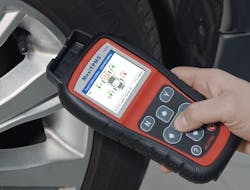Tire Pressure Monitoring Systems (TPMS) have been required systems on new passenger vehicles since late 2007. But still many shop owners remain unsure of their liability when servicing these systems and what the best method is to mitigate its exposure and ensure the safety of their customers’ vehicles.
Establish a standard operating procedure, educate your staff, and develop a partnership with a trusted tool and parts manufacturer. These are the keys to limiting a shop’s exposure and providing quality service for every successful repair shop, regardless of specialty, but especially when servicing TPMS.
It was the TREAD act, passed in 2000, that mandated TPMS on new vehicles. But the law most prevalent to repair shops is the Motor Vehicle Safety Act of 1966 and provision (49 USC 30122(b)) that forbids them from “knowingly making inoperative, in whole or in part, any part of a device or element of design installed on or in a motor vehicle in compliance with an applicable motor vehicle safety standard."
Where TPMS is concerned, this provision mandates repair shops cannot disable the system or the malfunction light, but also, must ensure that if the system was working when the vehicle came into the shop, it must be working when the vehicle is released to the customer. Failure to meet this provision can result in a shop receiving a civil penalty of up to $6,000 for each violation.
The Process
The first key to ensuring your shop is following provisions and ensuring safety, is to develop a standard operating procedure (SOP). When developing the business SOP, the first step must include a conversation with the customer regarding the status of the system and a test of the sensors and TPMS module itself, prior to any service on tire or rim.
The next step in a proper SOP is to check each wheel sensor with a proper TPMS tool that can activate the sensor. Autel offers a line of TPMS tools that can activate and read all known TPMS sensors, including displaying the battery condition of the sensor.
In addition to battery life, the elements also take a toll on sensors, particularly aluminum stems that often fall prey to corrosion on the outside or inside the stem. Test these next. Autel’s MaxiTPMS TS508 handheld and the TS608 Android tablet guide the user through the test, step by step.
Once the sensors are tested, the technician plugs the tool into the OBDII port and performs a quick status check on the TPMS module. A color-coded system status screen displays, identifying at-a-glance if the sensors are good, if the IDs were improperly registered or relearned to the vehicle, perhaps during a recent tire rotation, or if the fault lies with the module itself. With this knowledge, now the technician can speak to the customer about the current status of the system and what needs to be done to get it working properly.
Further Education
The second key is education and proper training for each staff member. Ensure your staff understand the basics of the system and the steps to service it so they can confidently share that information with their customers. When sharing this information, the customer must know the importance of this system and its importance to safety. The NHTSA estimates 660 people are killed in vehicle accidents each year as a result of underinflated tires. Properly inflated tires not only improve gas mileage but also contribute to vehicle stability, handling and braking ability and to the effectiveness of the Advanced Drive Assistance Systems in today’s vehicles.
A Trusted Partner
The third key is to partner with a company making tools that can get the job done consistently and effectively, while also offering a dependable and knowledgeable support staff that’s just a call or chat away. Autel is that company. Autel’s more than 15 years of experience in automotive diagnostics software makes it a proven and trusted source and partner. The company truly offers a complete solution by offering full service TPMS tools and programmable universal sensors. In fact, its dual frequency 1-Sensor can be programmed to replace 99 percent of the sensors on vehicles today.
For more information visit autel.com, maxitpms.com, or maxisysadas.com.





